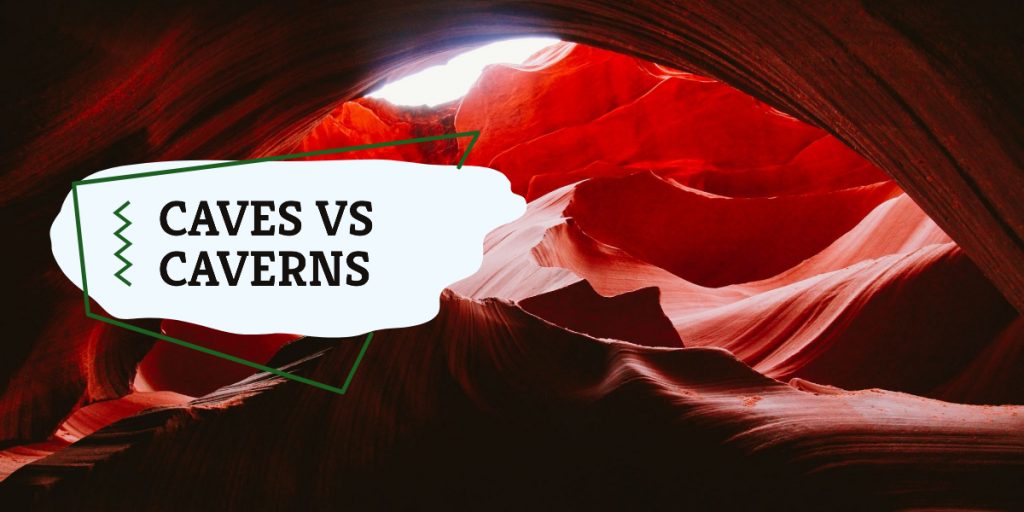Spelunking around in the caves of Texas or North America, you might have seen or heard the word cavern. Is it just another word for a cave, or is it something different?
Cave and cavern are considered synonymous, but technically there is a big difference.
Just a head start for you, all caverns are caves, but all caves are not caverns. Caverns are a unique type of cave with features not typical to an ordinary cave.
So let’s explore the differences between a cave and a cavern.
[toc]
What Is The Difference Between A Cave And A Cavern?
Caves
According to Encyclopedia Brittanica, “A cave is a natural opening large enough for human exploration.” The disintegration of rocks results in the formation of cavities. These cavities deepen over time and form caves. These caves can be vertical as well as horizontal depending on the shape of the rock.
Caves can either be classified as Primary or Secondary. Primary, caves are those, which developed while the host rock was still solidifying. On the other hand, secondary caves form after the host rock solidifies. Most caves on earth are secondary rocks. They form by the mechanism which transports rock materials away. These deep dark underground chambers take hundreds and thousands of years for their formation.
Caves are one of the many wonders of nature. A veil of dark cloak hides their natural beauty. They are always a source of exploration and recreation for nature lovers. They are found on cliffs, along with the coastline, and in the deep sea, hiding great wonders within them. They can even form in glaciers when the molten ice carves tunnel for its journey towards the sea.
Aren’t they just amazing!
Caverns
A Cavern is just another type of cave that is made from soluble rocks and grows speleothems. It can be much longer than an ordinary cave, like a long tunnel. Sometimes it so happens that a cave opens up into a cavern underground.
Speleothems are mineral deposits that droop on the walls and floor of the caverns due to continuous flowing, dripping, and seeping of water. This specific feature distinguishes caverns from caves. Speleothems grow in pointed shapes due to different salts and minerals present in water.
A cavern is a natural beauty in itself. The long pointed structures provide a beautiful spectacle. They store in them a long history and traces of the past, which are yet to be unveiled. Waitomo Glowworm Cave System, for example, traces back to 30 million years. It is known for its Glowworm Grottos that shine like blue stars.
Caverns are home to many small ecosystems and communities which are otherwise impossible on the ground. For Example, The Kentucky Caves, lying beneath Green River Valley in Kentucky, are an abode to a rich habitat of troglodytes, including eyeless fish, cave salamanders, and albino cave shrimp.
Caverns are no less either!
How Are Caves Formed?
Most of the caves form on Karst, a type of landscape containing limestone, dolomite, and gypsum that gets dissolved in acidic water. Rainwater mixes with CO2 as it falls on the ground. As it seeps further, it collects more CO2 from the soil. Hence this water becomes a little acidic that can dissolve calcite, the main mineral of Karst rocks.
This acidic rainwater percolates down, making its pathway through cracks and fractures, which creates a network of passages like an underground plumbing system. Eventually, some of these passages widen overtime to earn the distinction of a ‘cave.’ These caves take millions of years to expand large enough to hold a human.
How Caverns Form
Caverns are formed the same way as that of the cave. The disintegration of rocks through various chemical processes causes these cavities to form. Volcanic activities, soil erosion, and pressure can also lead to the formation of caverns.
The speleothems, drooping down the cave ceiling form when CO2 from the acidic water escapes, thus hardening the dissolved calcite again.
The water dripping from the cave roof results in an icicle-shaped formation called stalactites. These stalactites grow on the cave floor to form stalagmites. With time, sheets of calcite also grow on cave walls forming what we call as flowstones. These speleothems, stalactites, stalagmites, and flowstones collectively form the inner structure of a cavern. A cavern, therefore, is a much complex structure than a simple cave.
Now you know more about caves & caverns. Which one is your favorite? Let us know in the comments below.

